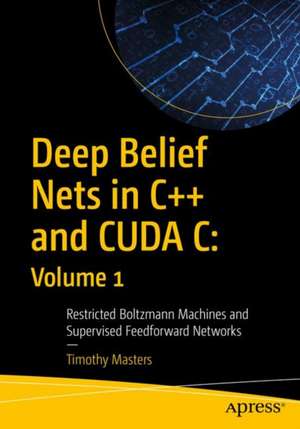Deep Belief Nets in C++ and CUDA C: Volume 1: Restricted Boltzmann Machines and Supervised Feedforward Networks
Autor Timothy Mastersen Limba Engleză Paperback – 24 apr 2018
Discover the essential building blocks of the most common forms of deep belief networks. At each step this book provides intuitive motivation, a summary of the most important equations relevant to the topic, and concludes with highly commented code for threaded computation on modern CPUs as well as massive parallel processing on computers with CUDA-capable video display cards.
The first of three in a series on C++ and CUDA C deep learning and belief nets, Deep Belief Nets in C++ and CUDA C: Volume 1 shows you how the structure of these elegant models is much closer to that of human brains than traditional neural networks; they have a thought process that is capable of learning abstract concepts built from simpler primitives. As such, you’ll see that a typical deep belief net can learn to recognize complex patterns by optimizing millions of parameters, yet this model can still be resistant to overfitting.
All theroutines and algorithms presented in the book are available in the code download, which also contains some libraries of related routines.
What You Will Learn
- Employ deep learning using C++ and CUDA C
- Work with supervised feedforward networks
- Implement restricted Boltzmann machines
- Use generative samplings
- Discover why these are important
Who This Book Is For
Those who have at least a basic knowledge of neural networks and some prior programming experience, although some C++ and CUDA C is recommended.
Preț: 180.20 lei
Preț vechi: 225.26 lei
-20% Nou
Puncte Express: 270
Preț estimativ în valută:
34.48€ • 36.10$ • 28.53£
34.48€ • 36.10$ • 28.53£
Carte disponibilă
Livrare economică 15-29 martie
Preluare comenzi: 021 569.72.76
Specificații
ISBN-13: 9781484235904
ISBN-10: 1484235908
Pagini: 231
Ilustrații: IX, 219 p. 33 illus., 20 illus. in color.
Dimensiuni: 178 x 254 x 19 mm
Greutate: 0.41 kg
Ediția:1st ed.
Editura: Apress
Colecția Apress
Locul publicării:Berkeley, CA, United States
ISBN-10: 1484235908
Pagini: 231
Ilustrații: IX, 219 p. 33 illus., 20 illus. in color.
Dimensiuni: 178 x 254 x 19 mm
Greutate: 0.41 kg
Ediția:1st ed.
Editura: Apress
Colecția Apress
Locul publicării:Berkeley, CA, United States
Cuprins
1. Introduction.- 2. Supervised Feedforward Networks.- 3. Restricted Boltzmann Machines.- 4. Greedy Training: Generative Samplings.- 5. DEEP Operating Manual.
Notă biografică
Timothy Masters received a PhD in mathematical statistics with a specialization in numerical computing. Since then he has continuously worked as an independent consultant for government and industry. His early research involved automated feature detection in high-altitude photographs while he developed applications for flood and drought prediction, detection of hidden missile silos, and identification of threatening military vehicles. Later he worked with medical researchers in the development of computer algorithms for distinguishing between benign and malignant cells in needle biopsies. For the last twenty years he has focused primarily on methods for evaluating automated financial market trading systems. He has authored five books on practical applications of predictive modeling: Practical Neural Network Recipes in C++ (Academic Press, 1993) Signal and Image Processing with Neural Networks (Wiley, 1994) Advanced Algorithms for Neural Networks (Wiley, 1995)Neural, Novel, and Hybrid Algorithms for Time Series Prediction (Wiley, 1995) and Assessing and Improving Prediction and Classification (Apress, 2018).
Textul de pe ultima copertă
Discover the essential building blocks of the most common forms of deep belief networks. At each step this book provides intuitive motivation, a summary of the most important equations relevant to the topic, and concludes with highly commented code for threaded computation on modern CPUs as well as massive parallel processing on computers with CUDA-capable video display cards.
The first of three in a series on C++ and CUDA C deep learning and belief nets, Deep Belief Nets in C++ and CUDA C: Volume 1 shows you how the structure of these elegant models is much closer to that of human brains than traditional neural networks; they have a thought process that is capable of learning abstract concepts built from simpler primitives. As such, you’ll see that a typical deep belief net can learn to recognize complex patterns by optimizing millions of parameters, yet this model can still be resistant to overfitting.
All the routines and algorithms presented in the book are available in the code download, which also contains some libraries of related routines.
You will:
- Employ deep learning using C++ and CUDA C
- Work with supervised feedforward networks
- Implement restricted Boltzmann machines
- Use generative samplings
- Discover why these are important
Caracteristici
Master deep learning with C++ and CUDA C Utilize restricted Boltzmann machines Work with supervised feedforward networks
